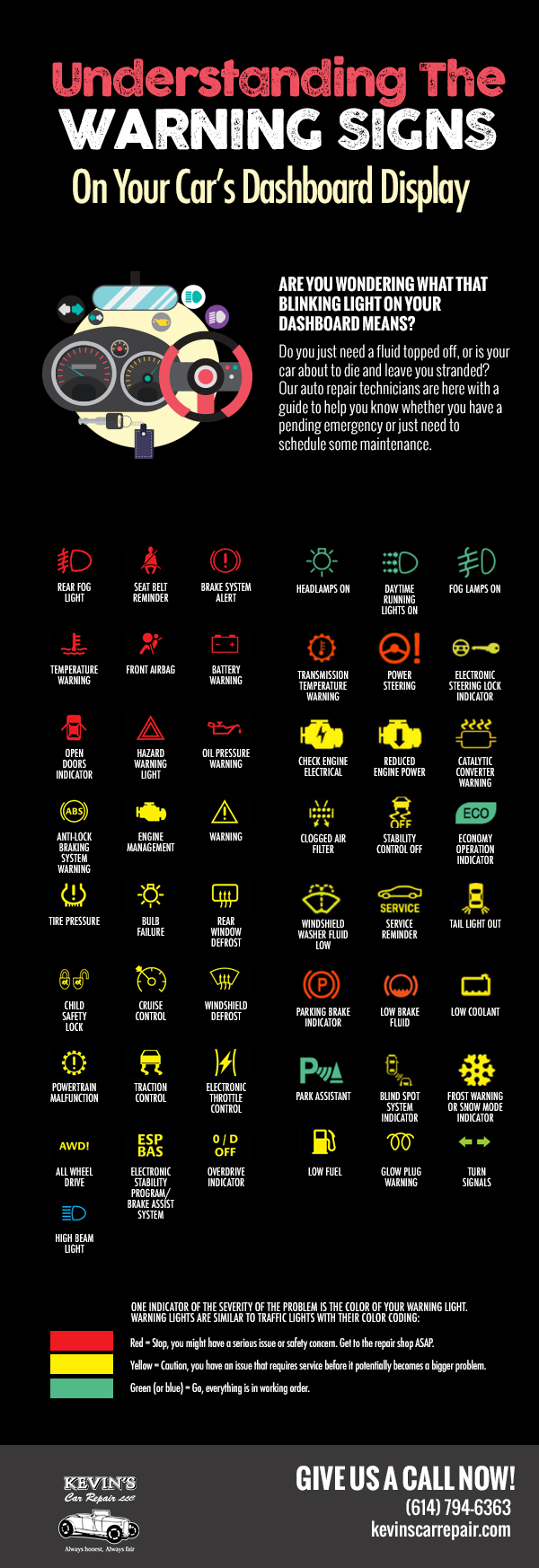Grasping The Importance Of Your Automobile'S Warning Signals: What They Actually Stand For
Grasping The Importance Of Your Automobile'S Warning Signals: What They Actually Stand For
Blog Article
Published By-Hartley Shepherd
When you're behind the wheel, those radiant warning lights on your control panel can be a bit perplexing. Do you understand what they're attempting to tell you about your auto's health and wellness? Comprehending the relevance of these lights is crucial for your safety and security and the longevity of your automobile. So, the next time one of those lights appears, wouldn't you wish to analyze its message accurately and take the required actions to address it?
Common Warning Lighting and Interpretations
Determine usual warning lights in your car and understand their significances to make sure risk-free driving.
The most normal caution lights include the check engine light, which signifies problems with the engine or discharges system. If this light begins, it's important to have your automobile inspected quickly.
The oil pressure cautioning light indicates reduced oil stress, needing immediate attention to prevent engine damage.
A blinking battery light might recommend a faulty charging system, possibly leaving you stranded if not addressed.
The tire pressure monitoring system (TPMS) light notifies you to low tire stress, affecting automobile stability and gas performance. Disregarding automatic car wash near me could bring about harmful driving problems.
The abdominal muscle light indicates a trouble with the anti-lock stopping system, endangering your ability to stop promptly in emergencies.
Lastly, the coolant temperature warning light warns of engine overheating, which can cause serious damages otherwise dealt with promptly.
Comprehending these typical warning lights will certainly help you resolve problems promptly and keep secure driving problems.
Importance of Prompt Interest
Understanding the common warning lights in your car is only the initial step; the importance of immediately resolving these warnings can't be highlighted enough to ensure your security when driving.
When a caution light brightens on your dashboard, it's your cars and truck's way of connecting a potential problem that requires focus. Overlooking these cautions can result in more severe troubles later on, endangering your safety and possibly costing you a lot more in repairs.
Motivate interest to alerting lights can avoid malfunctions and mishaps. As an example, a blinking check engine light could suggest a misfire that, if left ignored, might create damages to the catalytic converter. Addressing this immediately can save you from a costly repair work.
In a similar way, a brake system advising light might signal low brake liquid or used brake pads, vital parts for your safety when driving.
DIY Troubleshooting Tips
If you discover a warning light on your control panel, there are a few DIY fixing pointers you can attempt before seeking professional assistance.
https://www.wealthmanagement.com/net-lease/investment-activity-automotive-net-lease-assets-speeds is to consult your automobile's handbook to comprehend what the specific warning light suggests. Occasionally the issue can be as basic as a loose gas cap triggering the check engine light. Tightening up the gas cap may solve the problem.
One more common problem is a reduced battery, which can set off numerous warning lights. Checking the battery connections for deterioration and ensuring they're protected might take care of the problem.
If a caution light continues, you can try resetting it by detaching the automobile's battery for a couple of mins and then reconnecting it. Furthermore, checking your automobile's liquid levels, such as oil, coolant, and brake liquid, can help repair alerting lights related to these systems.
Conclusion
In conclusion, recognizing your automobile's caution lights is vital for keeping your car running efficiently and securely. By immediately dealing with these alerts and recognizing what they mean, you can prevent pricey repair services and prospective break downs.
Bear in mind to consult your car's manual for particular information on each alerting light and take action accordingly to guarantee a hassle-free driving experience.
Stay notified, remain risk-free on the road!
